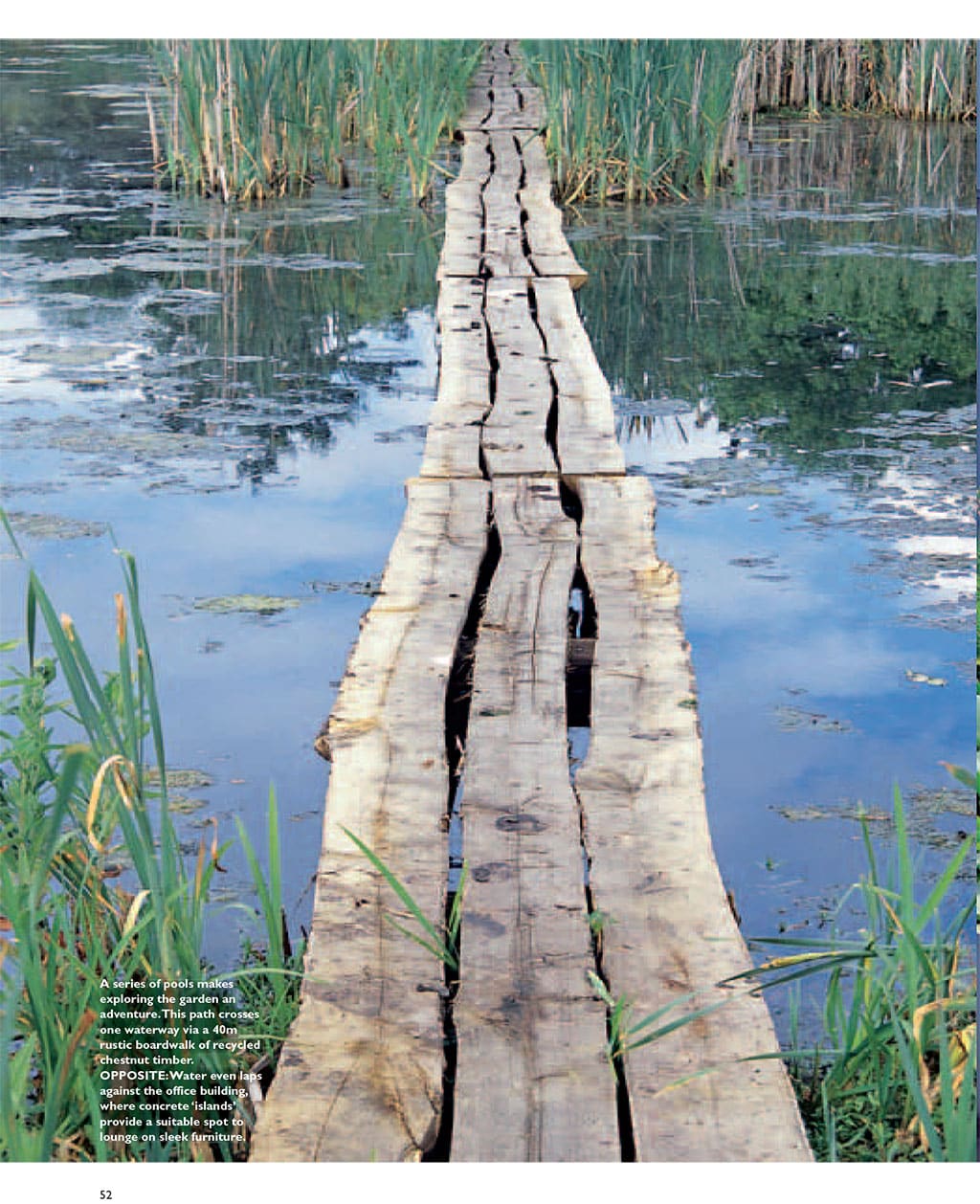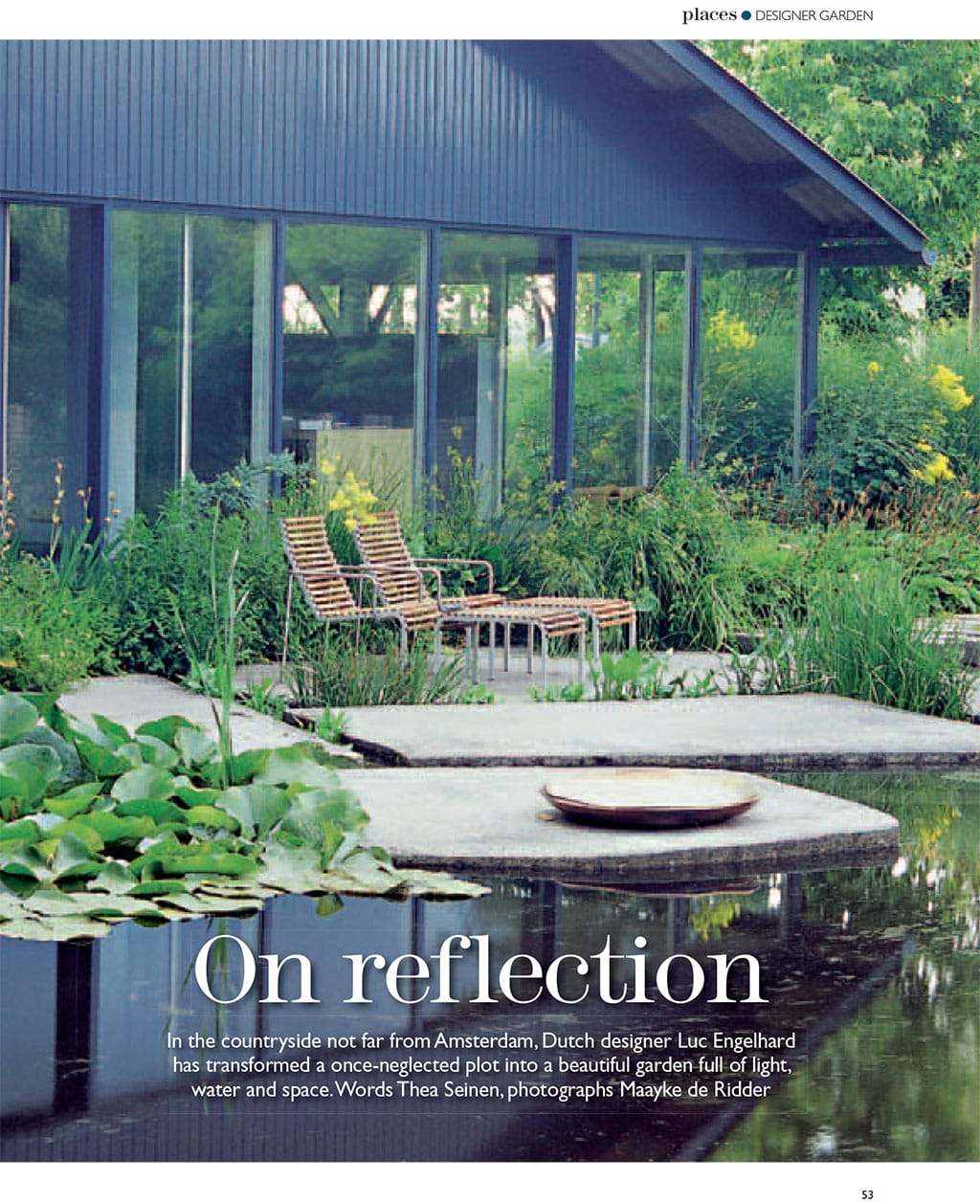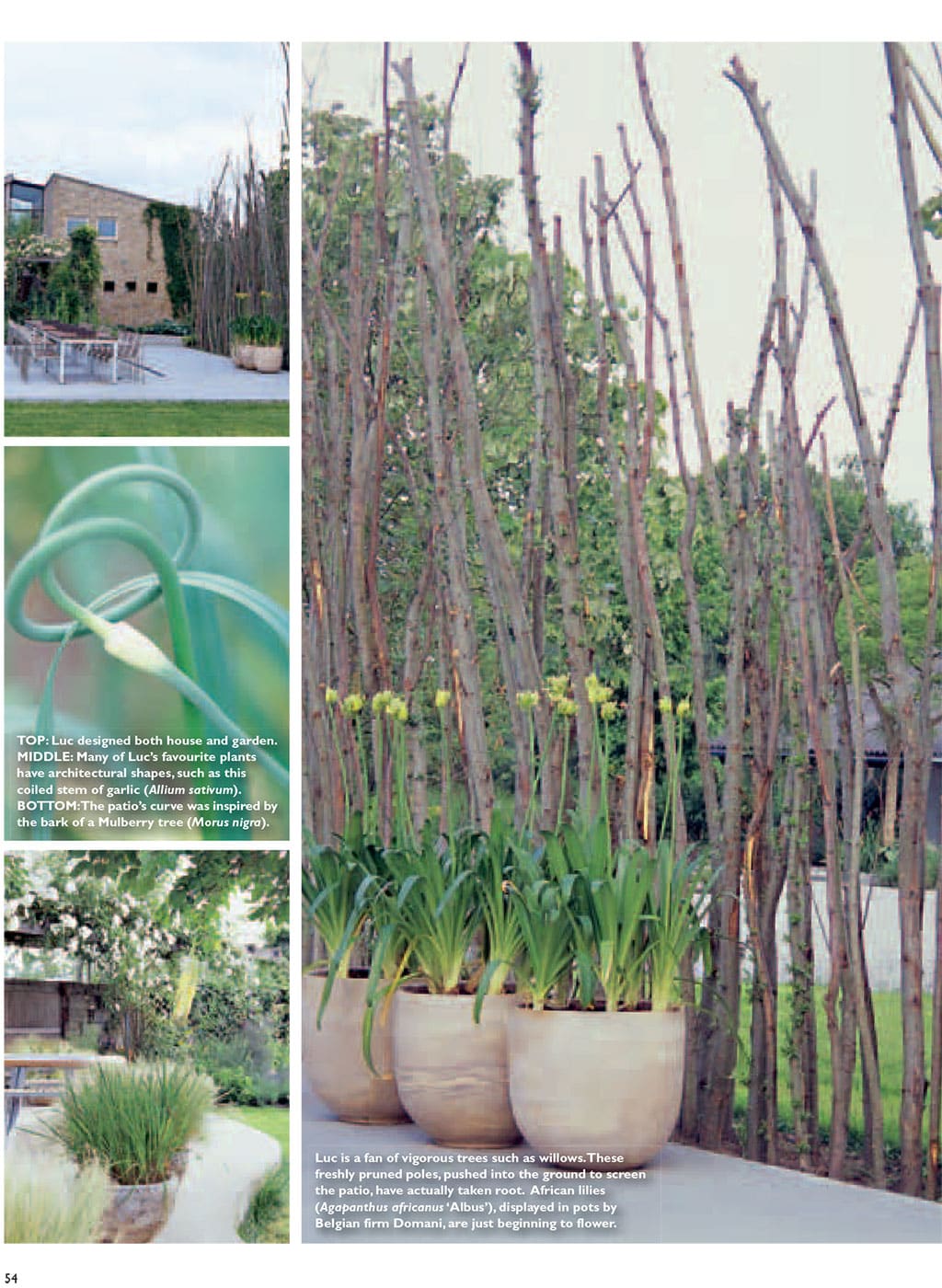On reflection
In the countryside not far from Amsterdam, Dutch designer Luc Engelhard has transformed a once-neglected plot into a beautiful garden full of light, water and space.
Words Thea Seinen, photographs Maayke de Ridder
DRIVING ALONG A COUNTRY LANE to Luc Engelhard’s garden, through lush pastures bounded by rows of pollarded willows, the hustle of the busy main road from Amsterdam to Utrecht behind you is soon forgotten. Luc, a garden designer, and his wife Christine came to this peaceful spot amid the water meadows of Spengen, 15km northwest of central Utrecht, in 1999. The 32-acre plot they bought then consisted of pastures, an orchard and a plantation of 50,000 conifers – the legacy of a nursery once based here. A derelict chicken shed and a few huts were the only buildings. Despite – or perhaps because of – its stark simplicity, Luc liked the feel of this place. He was soon living in a hut on site while he set about landscaping and planting the garden. An old shed became a makeshift office and canteen while he built a house and permanent office.
Creating the garden took all Luc’s experience as a garden designer – 17 years then, 25 now. There were practical considerations: the farm was 1.5m below sea level and its soil made of clay and peat. But Luc decided to make a virtue of this saturated terrain.
“In designing I always bring in elements of the surroundinglandscape,”Lucsays.“Herewaterisoneof the most important elements.” His design includes a series of ponds and waterways. One reaches as far as the foundations of the office, its still surface nearly touching the windows. From the office there is an uninterrupted view over the pond to the garden and the fields beyond. “The wonderful thing with water is that it changes with the weather and the skies above,” says Luc. “The reflec- tions of plants, trees, sculptures and buildings make it all the more fascinating. It is important to experience the seasons intensely in your own garden.”
STRIKING FEATURES
Sculptural forms are to be found all over the garden. Emerging from the water at the front of the house is one of the garden’s most striking features, a row of 30 low stone pillars (see page 57) built by Luc from paving stones cut into pieces and stacked in a spiral formation. The pillars seem to move and turn as you view them from different angles, an effect emphasised by changes in the sunlight and the reflections of the water. Such subtle and unexpected effects are deliberate. Luc says: “I like gardens that are not too predictable. There must always be something to discover. A garden must evoke a certain tension, a feel of expectation; a garden must surprise.”
Indeed, a walk through Luc’s garden is full of unex- pected pleasures. Paths lead everywhere, from the orchard and through a former pasture, where grasses are left to grow, to a rustic pergola made of recycled wood. A path of giant stone slabs laid almost haphaz- ardly leads to the waterside, opposite a field of grazing sheep. Another route winds its way to a little bridge; intrepid explorers with a good sense of balance can cross the water via a 40m chestnut boardwalk. On hot summer days Luc’s children like to jump into the water from a tree house in the overhanging boughs of a common alder (Alnus glutinosa) above it.
FURNITURE
Throughout the garden are beautifully designed tables, chairs, loungers, outdoor fireplaces, garden decorations and sculptures. Some are weather-beaten, others brand new – all are for sale, for the garden functions as an open-air showroom for Luc’s own collection and works by leading designers, including Moooi, Dedon, Extremis, Fermob and Domani.
Luc likes combining new and old natural materials in his furniture and buildings as well as in the hard landscaping of his gardens. For example, one of his tableshasastonetopandabrickworkbase,withapair of crude stools made from basalt blocks that were once part of one of the piers in Rotterdam harbour. One of his favourite materials is concrete, which he uses to make floors, table tops, chairs, bowls and vases.
INSPIRED PLANTING
Luc’s talent for furniture-making is obvious when you visit this garden but so too is his skill as a plantsman, the fruit of a spell at horticultural college and years of trial-and-error in the garden. He says he is always trying new plant combinations. The prairie-style planting in one sunny spot, for example, features Rosa‘Mermaid’,withitscreamy-yellowsingleflowers, scrambling through the upright clumps of purple moor grass (Molinia caerulea ‘Moorhexe’) and airy blue spikes of the relatively low-growing and wind- resistant Delphinium ‘Finsteraarhorn’. Purple Salvia x superba ‘Dear Anja’ provides another vertical accent, while the daisy-like flowers of Echinacea ‘White Swan’ tumble here and there. A shady bed combines false Solomon’s seal (Maianthemum racemosum), the glau- cous leaves of Hosta ‘Krossa Regal’ and the dense, mat-forming grass Luzula sylvatica ‘Bromel’.
Luc enjoys nurturing trees, too. He says he will even adopt trees that are no longer wanted because they have been neglected or badly pruned. “Structure, texture, bark, foliage, seasonal highlights and the way the foliage filters the light are my criteria when selecting trees,” he says. “I like trees thatsay‘thisisthewayIwanttogrow’,andgeton with it. I love willow and hawthorn. I always compare willows with teenagers,” says Luc, who has two children, aged 14 and 12. “They can show such unpredictable behaviour. One moment they are intensely annoying, and the next they are so incredibly nice you truly adore them.
“A willow has the capacity to rejuvenate itself constantly and becomes even more beautiful while aging. Hawthorns are heavily underestimated. In fact they are real fighters that manage to survive and grow under the most difficult circumstances.”
DESIGNER PROFILE
Designer Luc Engelhard was born in the city of Gouda, in the western Netherlands, and grew up in Woerden, near Utrecht. During a trip to France at the age of 18, he visited modernist designer Le Corbusier’s famous chapel Notre Dame du Haut and was so impressed that he decided he too wanted “to make the world more beautiful”. In 1983, after a spell at horticultural college in Utrecht, he started a garden design business. He now also designs furniture, vases and sculptures. Vital in creating gardens, he says, is “good cooperation and mutual understanding with clients”. He is currently busy with the design of several projects such as the gardens of an estate in Wassenaar, close to The Hague, and 7,000 square metre garden in the seaside town of Noordwijk.



SPRING
Because of the strength and beauty with which they grow and bud:
Horse chestnut (Aesculus); Kalopanax septemlobus var. maximowiczii; Astilboides tabularis; Gunnera.
SUMMER
For colour, texture and foliage:
Amur cork tree (Phellodendron amurense); white mulberry (Morus alba); smoke bush Cotinus coggygria ‘Royal Purple’; golden-rain tree (Koelreuteria paniculata); ornamental grasses, including Stipa tenuissima.
AUTUMN
The warmth of: Japanese maples;
Persian ironwood (Parrotia persica); Caucasian wing nut tree (Pterocarya fraxinifolia); sweet gum tree (Liquidambar styraciflua).
WINTER
For scented flowers:
Witch hazel Hamamelis x intermedia ‘Jelena’; wintersweet (Chimonanthus praecox).
Beautiful bark and texture:
Tibetan cherry tree (Prunus serrula); paper- bark maple (Acer griseum).